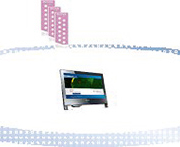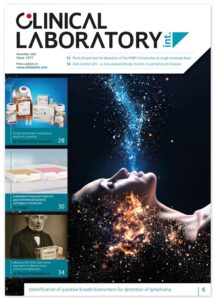Significant workflow improvement and cost savings for antinuclear antibody testing on HEp-2 substrate using an automated process
The antinuclear antibody (ANA) test is a standard screening assay for detecting multiple autoantibodies that may be produced by a patient with an ANA associated rheumatic disease (AARD). Patients with these AARD often present with vague symptoms posting challenges to make an early and accurate diagnosis. The presence of ANAs assists physicians in making a definitive diagnosis of AARD. During the past decade laboratories have tried to move ANA testing by IIF to solid-phase assays. However, solid phase technologies such as bead-based or enzyme-linked immune assay (ELISA) have their own limitations [1-4]. Although there are several methodologies available to screen ANA, in 2009 a task force of the American College of Rheumatology (ACR) issued a statement declaring HEp-2 indirect immunofluorescence (IIF) as the preferred method for ANA screening [5,6].
by Deborah S. Stimson CLS1, Claudia A. Ibarra CCS, MB (ASCP)
The ACR declaration was based on the findings of the task force which collected information from physicians to evaluate non-standardization of the various methodologies on the market for evaluating ANA. Using HEp-2 cells as the substrate, IIF allows detection of over 100 autoantibodies to different nuclear and cytoplasmic antigens [7].
There are 5 to 6 nuclear patterns that are commonly reported. These are: homogeneous, speckled, centromere, nucleolar, dense fine speckled, and nuclear dot. The pattern and titre aid the physician when deciding what further tests to order, if any.
Performing IIF is labour-intensive, subjective, and prone to transcription errors and reader bias. Technologists reading IIF must be well trained and experienced in the interpretation of the complex patterns [7-10].
After the ACR’s 2009 statement, the demand for IIF testing has outpaced the typical laboratory’s capability to perform this test manually. Implementing HEp-2 IIF testing to abide by the recommendations issued in the ACR statement presents a challenge to most laboratories. As newer test technologies emerged, the number of laboratories with knowledge and skill to perform ANA IIF declined. The cost of personnel can be prohibitive, considering the number of staff members who must have skills and expertise to run and interpret ANA IIF. There is a need for automation and standardization of ANA IIF. Since 2002 several studies of automated or digital IIF instruments for positive and negative discrimination have been performed. Some systems incorporate pattern recognition algorithms. All conclude that automated IIF analysis will improve inter- and intra-laboratory results [11-19].
To address the increased demand for ANA testing using HEp-2 IIF, and to overcome problems with manual performance of HEp-2 testing, Inova Diagnostics developed the Integrated Lab [11-19]. To automate IIF processing, the Integrated Lab uses QUANTA-Lyser®; to automate IIF interpretation, it uses NOVA View® with a digital IIF microscope (recently cleared through the FDA no. DEN140039); and to simultaneously confirm and report results directly to the LIS, it uses QUANTA Link® software. The new instrument configuration delivers positive patient identification for IIF samples, thereby eliminating the need for manual transcription, it provides a paperless laboratory environment, while reducing variability and hands-on time.
Materials and methods
Following the manual method currently in use by the lab, a single ANA run of 118 samples was performed and then positive samples were titrated. Subsequently, the same 118 samples were processed, read, and titres reported using the automated Integrated Lab. The Integrated Lab configuration implemented at Exagen consists of three primary instruments, QUANTA-Lyser EIA/IIF processor which processes, and reads and interprets NOVA Lite® bar coded slides to allow positive patient identification, NOVA View digital IIF microscope acquires, displays, and suggests interpretation of HEp-2 IIF images, and QUANTA Link a bi-directional software, as shown in Figure A. A single run of 118 samples sent to Exagen for ANA IIF were used for this study. The samples were processed both manually and using the QUANTA Lyser 240. IIF screens and endpoint titres were read manually on an Olympus BX41 halogen microscope and also with digital images captured by NOVA View. Manual results were reported by transcribing them onto a template in the darkroom, then transcribing them a second time into the LIS. Integrated Lab results were automatically reported to the LIS using QUANTA Link. The kit for both manual and automated runs was the NOVA Lite® HEp-2 IgG ANA kit with DAPI, containing barcoded slides. After screening, forty-two of the 118 samples (36%) produced positive results. In the manual method, the forty-two samples were serially diluted to determine the endpoint titre. By comparison, the Integrated Lab configuration utilizes a unique Single Well Titre (SWT) feature on NOVA View to predict an endpoint titre from the screening well result. The SWT function automatically predicts an endpoint titre using a series of standard curves programmed into the software. Each of the 5 recognized patterns is matched to a specific curve. The SWT feature on NOVA View can be used for up to eight of the most common IIF patterns and does not require additional dilution steps. This study was conducted to quantify hands-on time required to perform our ANA IIF testing, comparing tests run manually with tests run on the Integrated Lab. Each step was timed using a stop watch. Subsequently a 5-month retrospective study to quantify reagent cost savings due to using the Integrated Lab was performed.
Results
Both methods examined 118 screens and 42 endpoint titres; the manual method required 288 HEp-2 wells, while the Integrated Lab used 120 wells. Processing samples on QUANTA-Lyser requires two wells per run of slides designated for controls compared to running manually which requires a positive and negative control on each slide. The SWT feature on NOVA View reduced the number of IIF wells by 58% or 168 wells. Screening results: The Integrated Lab reduced the hands-on time from sample processing through confirmation and reporting results by 64%, from 205.2 minutes manual run to 74.5 minutes. Using the NOVA View to predict endpoint titre eliminated the need to make serial dilutions or process additional wells. Processing 42 positive ANAs, this automated feature reduced total hands-on time by 202 minutes compared to the manual method.
Using the Integrated Lab reduced hands-on time by 82% or 5.5 hours per day compared to the manual IIF process. (Table 1) The outcome was a total annual reduction of 1,442 staff hours. Complete details are compared in Figure B. In 5 months 19,321 ANA IIF sera had been run using the Integrated Lab. A breakdown of results is shown in Table 2. Using the manual method the positive screens would be titrated the following day using 5 wells per patient to ensure finding the endpoint and reporting results 24 hours after the screen. (Table 3) With the SWT application the results with pattern and titre were reported out the same day seconds after the ANA screen result was determined. This saved 24 hours per patient in TAT for reporting. It also saved the laboratory 50,665 HEp-2 wells in 5 months.
Discussion
Recent recommendations from the ACR to use ANA HEp-2 IIF as a screening test for ANA as an aid in the diagnoses of AARD have led to an increased number of ANA IIF tests being ordered. The Integrated Lab provided the solution for automating ANA IIF that helped meet these challenges. At Exagen, the time study we conducted demonstrated a reduced hands-on time of 82% from 407.2 to 74.5 minutes and allowed faster turn-around time by delivering same day results for endpoint titre. Endpoint titre results, using NOVA View’s SWT function reduced the number of additional IIF wells and time to process endpoint titre results allowing same day reporting along with cost savings. Using the NOVA View digital images has also provided standardization among IIF readers, who now enjoy the ability to read and consult using the same digital image at any time. This was an added benefit. We found that this sophisticated, automated technology led to workflow efficiencies and a cost effective alternative to the manual IIF procedure in our laboratory.
We redirected labour savings to developing areas and expanded the tests our lab offers, while satisfying the requests of our clients for ANA titre and pattern. This study was focused on the workflow optimization and cost savings not on analytical or clinical performance which have been addressed in previous studies with convincing outcome.
References
1. Agmon-Levin N, et al, Ann Rheum Dis. 2014 Jan:73(1):17-23 doi: 10.1136/annrheumdis-2013-203863. Epub 2014.
2. Fritzler Fritzler MJ, et al. J Rheumatol. 2003;30:2374-2381.
3. Peterson LK, et al. J Immunol Methods. 2009;349:1-2.
4. Tonuttia E, et al. Autoimmunity. 2004;37:171-176.
5. Tan EM, et al. Arthritis Rheum. 1999;42:455-464.
6. American College of Rheumatology. Current Practice Issues: ACR Tracking Concerns About ANA Testing Results. Atlanta, GA: American College of Rheumatology; 2009.
7. P. L. Meroni and P. H. Schur, Annals of the Rheumatic Diseases, vol. 69, no. 8, pp. 1420–1422, 2010.
8. R. W. Burlingame and C. Peebles, K.M. Pollard, Ed., pp. 159–188,Wiley-VCH, Weinheim, Germany, 2006.
9. S. S. Copple, et al. American Journal of Clinical Pathology, vol. 137, pp. 825–830, 2012.
10. B. M. Van, et al. Clinical Chemistry and Laboratory Medicine, vol. 47, no. 1, pp. 102–108, 2009.
11. X. Qin, et al. Nan Fang Yi Ke Da Xue Bao, vol. 29, no. 3, pp. 472–475, 2009.Pathology, vol. 137, pp. 825–830, 2012.
12. Edgner W. The use of laboratory tests in the diagnosis of SLE. J Clin Pathol, 2000:53:424-432.
13. Fenger M, et al. Clin Chem. 2004;50:2141-2147.
14. Swaak AJ. Ned Tijdschr, Geneeskd. 2000:144:585-589.
15. P. Perner, et al. Journal Artificial Intelligence in Medicine, vol. 26, no. 1, pp. 161–173, 2002.
16. K. Egerer, et al. Arthritis Research & Therapy, vol. 12, article R40, 2010.
17. R. Hiemann, et al. AutoimmunityReviews, vol. 9, no. 1, pp. 17–22, 2009.
18. A. Willitzki, et al. AutoimmunityReviews, vol. 9, no. 1, pp. 17–22, 2009.
19. J. Voigt, et al. Clinical and Developmental Immunology, vol. 2012, Article ID 651058, 7 pages, 2012.
20. D. Roggenbuck, et al. Clinical Chemistry and Laboratory Medicine, vol. 52, no. 2, pp. e9–e11, 2013.
21. C. Bonroy, et al. Clinical Chemistry and Laboratory Medicine, vol. 51, no. 9, pp.1771–1779, 2013.
22. X. Bossuyt, et al. Clinica Chimica Acta, vol. 415, pp. 101–106, 2013.
23. P. Foggia, et al. IEEE Transactions on Medical Imaging, vol. 32, no. 10, pp. 1878–1889, 2013.
24. D. Roggenbuck, et al. Clinica Chimica Acta, vol. 421, pp. 168–169, 2013.
The authors
Deborah S. Stimson CLS1, Claudia A. Ibarra CCS, MB (ASCP)1, Vice President, Laboratory Operations Exagen Diagnostics
1Exagen Diagnostics, Vista, CA. 92081, USA.
Corresponding author: Claudia Ibarra
1261 Liberty Way, Vista, CA 92081, USA.
Tel. 888-452-1522
E-mail: cibarra@exagen.com



